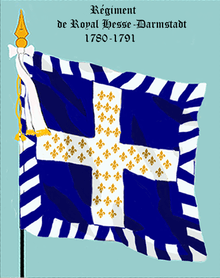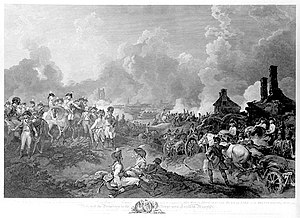Régiment Royal de Hesse–Darmstadt
The Régiment Royal de Hesse–Darmstadt was a German regiment of the Royal French Army which served during the 18th century before converting to the 94th Infantry Regiment. The regiment's successor would continue to serve the French Army until 1993 when it was disbanded after the end of the Cold War.
| Régiment Royal de Hesse–Darmstadt 94éme Régiment d'Infanterie de Ligne (Hesse–Darmstadt) | |
|---|---|
 Regimental colours, and its distinctive blue of the German regiments. | |
| Active | 1780–1794 |
| Country | |
| Allegiance | King of France French Nation |
| Branch | |
| Type | Line Infantry |
| Size | 2 Line Battalions |
| Garrison/HQ | Strasbourg |
| Engagements | War of the First Coalition |
Formation

The Régiment Royal–Bavière was formed as one of the last infantry corps formed by Louis XIV in 1709, although it could be traced back to 1703 by orders of the Elector of Bavaria to raise a regiment in service of the French during the War of the Spanish Succession. In 1780, this regiment was renamed as the Régiment Royal de Hesse–Darmstadt when Louis IX, Landgrave de Hesse-Darmstadt took over as regimental colonel. Because the regiment was formed after the publishing of the 1779 ordnance, the uniform was the same as the predecessor. On 1 October 1786 a small ordnance was published, and the regiment uniform became; blue coat, vivid orange facings, vivid orange lapels, vivid orange cuffs, vivid orange trimmed epaulettes, vivid orange trimmed pockets, and a black bicorne with the bourbon white cockade.[1][2]
Revolution
Formed in Brest, the regiment then moved to Strasbourg in October 1783, to Fort-Louis in October 1785, and returned to Strasbourg in June 1786. While the regiment was in Strasbourg, they received the news of the Storming of the Bastille, and were full of joy, as apposed to the government which felt much the opposite. After many issues with local royalists, the regiment was granted the first tricolour cockade awarded to the army. It was at this point where it became part of the permanent Strasbourg garrison, and hailed as heroes by the local population for supporting the revolution.[1]
In a move to end the royalist elements, all regiments were renamed to be given their order of precedence, therefore the Hess-Darmstadt regiment became the 94éme Régiment d'Infanterie de Ligne (Hesse–Darmstadt).[1]
French Revolutionary War

In June 1790, the regiment moved to Givet, from where it detached the 2nd battalion to Rocroi in August. The two battalions reunited in Mézères in April 1791. On 1 April 1791 Provisional regulations were published which grouped regiments as far as uniforms went, but this didn't include the foreign regiments which maintained their separate uniforms. Under these regulations, the regimental uniform changed to become; Blue jacket, blue lapels, red facings, black trimmed epaulettes and buttons, black tricorne, and the bourbon white cockade in the hat. The next year this cockade was replaced by the republican red, white, and blue cockade of France, and the hat replaced by a peaked casque (resembling a Tarleton helmet).[1][2]
In 1792 as the War of the First Coalition began, the 2nd battalion remained in Mézères while the 1st battalion was called up to join the Army of the Centre Armée du Centre. The 1st then contributed to the Battle of Valmy and the subsequent Flanders campaign and spent the winter in Mechelen. In 1793 the battalion was transferred to the Army of the North Armée du Nord, and after the Siege of Valenciennes, it then transferred to the Vendée.[1]
While the 1st saw action in the north, the 2nd battalion served under Jean-Baptiste Jourdan in the Army of the Ardennes Armée du Ardennes and the Army of the Sambre and Meuse Armée du Sambre et Meuse.[1]
The years following the Revolution saw great changes for the French Army: the old royalist infantry regiments were to serve as the stiffening for the tens of thousands of new volunteers who answered the patriotic Levée en masse. In the First Amalgamation of 1794, each old royalist battalion was put together with two new volunteers battalions to become new Demi-Brigade de Bataille or Demi-Brigade of Battle. On 26 March 1794 the 2nd battalion amalgamated with the 1st Battalion of Chaumont (Upper-Marne) and 10th Battalion of the Jura to form the 172éme Demi-Brigade. On 31 December 1794 the 1st battalion amalgamated with the 2nd Battalion of the Marne and 2nd Battalion of the Upper Alpes to form the 171éme Demi-Brigade.[1][3][4][5]
Uniform
Regimental uniforms throughout the later part of its history included:
 Regimental uniform after the provisional 1786 regulations.
Regimental uniform after the provisional 1786 regulations. Corporal of Chasseurs uniform in 1791 after the 1791 provisional regulations.
Corporal of Chasseurs uniform in 1791 after the 1791 provisional regulations.
Colours
A typical regiment consisted of (until 1791) two colours; Regimental Colours Drapeau d'Ordonnance and the Colonel's Colours Drapeau de Colonel, which the later normally consisted of the bourbon flag (pure white) with a light grey trimmed cross imposed throughout. Being a German regiment, the Hesse–Darmstadt maintained a different colonel's colour which included; the image of conception in the centre of a cross. The regimental colours consisted of; a cross dotted with golden lilies and azure quarters, they were surrounded by a wide blue and white border of alternating diamonds.[1]
 Colonel's colours of the Royal Bavarian Regiment, very similar to its successor.
Colonel's colours of the Royal Bavarian Regiment, very similar to its successor. Regimental colours, and the distinctive blue of the German regiments.
Regimental colours, and the distinctive blue of the German regiments. 1st battalion's colours just before its absorption into the 171st Demi-Brigade.
1st battalion's colours just before its absorption into the 171st Demi-Brigade. 2nd battalion's colours just before its absorption into the 172nd Demi-Brigade.
2nd battalion's colours just before its absorption into the 172nd Demi-Brigade.
Commanding Officers
Commanding officers of the regiment included:[1]
- 1780–1783 Louis IX, Landgrave de Hesse-Darmstadt
- 1783–1791 Frédéric-Louis, Prince de Hesse-Darmstadt
- 1791–1791 Jacques d'Alençon
- 1791–1791 Frédéric Charles de Haack
- 1791–1791 Nicolas de Roques
- 1791–1792 André Hamilton
Footnotes
- Susane, Volume VII, pp. 263–279.
- Lienhart & Humbert, pp. 42–44.
- Susane, Volume I, pp. 356
- Smith, Uniforms of the Napoleonic Wars, p. 42–46.
- Smith, Napoleon's Regiments, pp. 120–121, 145.
References
- Louis Susane, Historie de l'Ancienne Infanterie Français, Volume I [in French], 1849 Naval and Polytechnical Military Library of Paris, Paris, France.
- Louis Susane, Historie de l'Ancienne Infanterie Français, Volume VII [in French], 1853 Naval and Polytechnical Military Library of Paris, Paris, France.
- Dr. Constance Lienhart & Réne Humbert, The Uniforms of French Armies 1690–1894; Volume 3: The Infantry, Originally published in 1906, re-printed in 2020, Zanica, Italy. ISBN 978-8893275255.
- Digby Smith, Napoleon's Regiments: Battle Histories of the Regiments of the French Army, 1792–1815, 2000 Greenhill Books, London, United Kingdom. ISBN 1-85367-413-3.
- Digby Smith & Jeremy Black, An Illustrated Encyclopedia of Uniforms of the Napoleonic Wars, 2015 Lorenz Books, London, United Kingdom. ISBN 978-0-7548-1571-6.